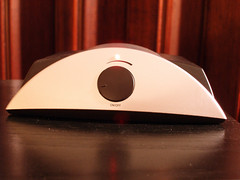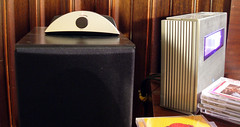
A week or two ago the geek-oriented blogosphere was abuzz with a little $30 battery-powered audio amplifier that was blowing people away with its sound quality. Some were even comparing it favorably to near-thousand dollar tube amplifiers.
I’m normally pretty skeptical about snowball effect of the blogosphere and the geek-obsession of the moment. But I’m also a push-over for a crazy tech bargain. In particular, the review by TNT-Audio convinced me that I should give the Sonic Impact T-Amp a shot. I’ve read TNT for years and generally found their reviews to be very critical and not particularly susceptible to hype.
More importantly, what convinced me was that the heart of the amp is a digital switching amplifier chip. This is a technology I’ve been convinced offers very high quality sound, with great efficiency with regard to size, energy consumption and heat production.
My main two-channel stereo is actually driven by a digital amp in a Sharp mini-system that you’d never otherwise believe is a Sharp or a mini-system once you hear it. (For more details on it, read my review over at Epinions).
Unfortunately, I waited a few too many hours (?!?) after first reading about the damn things on boingboing such that the supply dried up at most major on-line retailers. So I turned to our old friend eBay. Luckily, dealers hadn’t quite yet gotten wind of the shortage, so I could get a new one for a buy-it-now price no more than what the average retailer had been asking.
I got the amp last week, but only finally got a chance to plug it in today. I have to admit that he hype is not misplaced.
Now, first off, when you open up the box, what you have in your had definitely looks like a $30 piece of plastic. There is nothing about the unit that screams quality whatsoever. It’s battery powered (or you can use an AC adaptor), but the 8 AA batteries are a royal pain to put in — very poor design.
After the five minutes it took to get the batteries in, I plugged in the preamp out of my Sharp minisystem and my Polk RT600I main speakers, then put on a CD. I would not say I was blown away — there is simply not enough power to do that. But I was pleasantly surprised. The sound was clean, detailed, without a hint of distortion or added noise — all the hallmarks of good digital amplification.
Then I connected the amp’s inputs directly to my Pro-Ject Phonobox to get audio direct from my turntable. I slapped on Ornette Coleman’s The Shape of Jazz to Come and it sounded like it’s supposed to. Again, good separation of instruments, decent detail, and no overemphasis of any frequency. Very smooth response, if a bit lacking in bass capability.
The T-Amp is rated for 15 watts, and most accounts put the real-world output at more like half that. And yet, it’s enough to power some decently sensitive speakers to fill a room with fine sound. Wattage can be very overrated, and many tube amp enthusiasts pay lots of money for amps that don’t put out much more power than the T-Amp.
Bass is certainly present with the T-Amp, it just isn’t there with any authority or magnificence. But, at least it isn’t muddy, nor does the T-Amp commit the sins of many cheaper amps, which is to unnaturally emphasize the mid-bass frequencies to make up for lack of true low-bass.
It’s kind of funny, but right now I really don’t need an extra audio amp. I’ve got a stereo in nearly every room (except the bathrooms, which just have radios). But the T-Amp makes me want to assemble a bargain stereo.
With judicious selection of used or clearance gear, you could make the T-Amp the center of a very nice system for a hundred or two that would blow away most mini-systems you could buy for up to double that.
If you plan to run the T-Amp off wall power, I’d encourage you to get a decent AC adaptor — you might have to spend more than the amp costs. The reason I give this advice is because AC adaptors often pass a 60 Hz hum right on up to the equipment due to poor shielding. This hum can wreak havoc with amplifiers and preamps if not effectively isolated or filtered out.
I currently have a little hum problem with my turntable and preamp combo, which, incidentally, utterly disappeared with the T-Amp running off batteries, since that gets rid of the possibility for a ground loop.
I think the only place you can find T-Amps right now is eBay, and a quick search shows them still going for about $30, though a lot of sellers are jacking up the shipping costs. If you can find one for not much more than $30 it’s definitely worth it — you really can’t go wrong.
If you can’t lay your hands on one now, they might step up production soon. Or you can wait a little bit and get the T-Amps new big brother, the forthcoming T-Amp2. The updated version will cost you more like $139, but according to early reviews, the improvements to build quality and connectors are worth it. We shall see.
Sometimes, there is still a bargain to be had in audio if you don’t buy into the equation that good sound must cost an arm and a leg.
